
Manure Tractor Supply: Your Guide to Healthier Soil
Let's talk about naturally boosting your soil's health. Using manure, readily available at Tractor Supply and other retailers, is a fantastic way to improve soil health and increase your harvest. But before you grab a bag, let's cover some essentials. This guide will provide a practical, step-by-step approach to using manure effectively, empowering you to cultivate a thriving farm or garden. For essential minerals, consider supplemental options.
Understanding Your Soil: It's More Than Just Dirt
Think of your soil as a living organism needing nourishment to thrive. Different plants require different nutrients, and your soil's composition is unique. A soil test (easily obtained locally) is your first crucial step. This inexpensive analysis reveals nutrient deficiencies, ensuring you address specific needs rather than relying on guesswork. It's like getting a personalized health checkup for your soil. Knowing what your soil lacks allows precise amendments, optimizing your resources and maximizing yields.
Choosing the Right Manure: More Than Just Cow Pies
Tractor Supply and other retailers offer various manure types, including cow, chicken, and composted blends. Each type possesses unique nutrient levels, impacting plant growth. Cow manure is a versatile choice, while chicken manure, high in nitrogen, requires composting before application to avoid damaging plants. Read labels carefully, noting nitrogen (N), phosphorus (P), and potassium (K) levels – the essential nutrients for healthy plant growth. Choosing the right manure is like selecting the right ingredients for a recipe; the correct nutrient balance ensures optimal plant health.
Applying Manure: A Step-by-Step Guide
Applying manure effectively involves a systematic approach. Remember, consistency and attention to detail ensure optimal results.
Prep the Area: Clear away weeds, rocks, and debris to ensure even manure distribution. This is like preparing a seedbed for optimal germination.
Consider Retesting: Many farmers re-test their soil after initial testing but before manure application to fine-tune their approach. This preemptive measure helps customize application rates for precision farming.
Spread the Manure: Use a wheelbarrow for small areas or a spreader (available at Tractor Supply) for larger areas. Always adhere to package instructions for application rates, ensuring even coverage.
Incorporate (Sometimes): Gently tilling the manure into the topsoil accelerates decomposition and nutrient uptake. However, certain manure types and crops benefit from surface application. Always consult package directions for optimal results. Remember, this step depends on the specific manure type, soil conditions, and crop requirements.
Beyond Manure: Holistic Soil Care
While manure is beneficial, it’s one piece of the puzzle. Sustainably healthy soil requires a multifaceted approach.
Crop Rotation: Alternating crops annually prevents nutrient depletion and pest buildup.
Cover Cropping: Planting non-harvested crops, like clover or rye, improves soil structure and adds organic matter.
Composting: Creating compost enriches soil with nutrients and improves structure.
These techniques work synergistically to create robust, resilient soil, increasing yields and reducing reliance on chemical fertilizers.
The Risks and Rewards: A Balanced Perspective
Manure application, while beneficial, presents potential risks:
Potential Risks & Mitigation:
| Risk Factor | Probability | Impact | Mitigation Strategy |
|---|---|---|---|
| Uneven Manure Application | Medium | Reduced Crop Yield | Careful spreading; consider using a spreader. |
| Excess Nutrients | Low-Medium | Potential Water Pollution | Follow application instructions; soil testing is crucial. |
| Unwanted Seeds or Pathogens | Low | Reduced Crop Health | Use high-quality, composted manure; ensure it's pathogen-free. |
| Regulatory Non-Compliance | Low | Fines/Legal Issues | Check local regulations before applying any manure. |
Consult your local agricultural extension service for detailed information on regulations and best practices.
Monitoring Your Success: The Proof Is in the Plants
Regularly monitor soil health by continuing soil testing and observing plant growth. This iterative process allows you to refine your approach, ensuring sustainable success. The visible results – healthy, thriving plants – are your best indicator of a healthy soil ecosystem.
Building Soil Fertility: A Long-Term Investment
Building healthy soil is a long-term commitment. However, investing in soil health sets you up for years of successful harvests, reducing chemical fertilizer reliance, and fostering ecological balance. The payoff is sustainable yields and environmentally sound farming practices.
Comparing Long-Term Effects of Cow Manure vs. Other Organic Soil Amendments on Carbon Sequestration
Healthy soil is crucial for sustainable farming, and carbon sequestration – the process of absorbing atmospheric carbon – is a significant benefit of healthy soil. Let's explore how different organic soil amendments, including cow manure, compare in their long-term impact on carbon sequestration.
Understanding Carbon Sequestration
Soil acts as a carbon sink, absorbing atmospheric carbon. Adding organic matter, like manure, enhances this capacity, benefiting both the environment and crop production. This is a crucial aspect of sustainable agriculture.
Cow Manure: The Classic Choice
Cow manure, readily available and cost-effective, boosts soil carbon levels by increasing organic matter. However, appropriate application rates are vital. Overapplication can lead to nutrient runoff and greenhouse gas emissions. Careful management is key to achieving positive gains.
Other Organic Amendments: Expanding Your Options
Compost, cover crops, and biochar offer alternative pathways to carbon sequestration. Compost offers a more stable, slower carbon release, while cover crops enhance biodiversity and soil health. Biochar, an excellent carbon sink, needs careful production and application. The most effective approach often involves a combination of these methods.
Optimizing Your Approach
Soil Testing: Conduct soil tests to pinpoint nutrient deficiencies and guide amendment selection.
Manure Handling: Proper storage minimizes greenhouse gas emissions and nutrient loss. Consider anaerobic digestion to create biogas.
Integrated Approach: Combining manure with other amendments yields synergistic benefits.
Monitoring and Adjustment: Regularly monitor soil carbon levels to assess your strategy.
Key Takeaways:
- Different amendments have varying impacts on carbon sequestration.
- Cow manure is cost-effective but requires careful management.
- Other amendments offer alternative strategies, and integrated approaches may be most effective.
- Site-specific soil testing is essential for maximizing results.